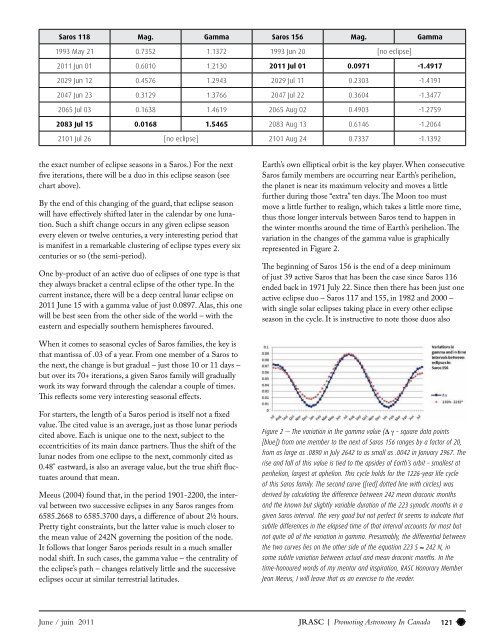The Running Man Nebula
The Running Man Nebula - The Royal Astronomical Society of ...
The Running Man Nebula - The Royal Astronomical Society of ...
You also want an ePaper? Increase the reach of your titles
YUMPU automatically turns print PDFs into web optimized ePapers that Google loves.
Saros 118 Mag. Gamma Saros 156 Mag. Gamma1993 May 21 0.7352 1.1372 1993 Jun 20 [no eclipse]2011 Jun 01 0.6010 1.2130 2011 Jul 01 0.0971 -1.49172029 Jun 12 0.4576 1.2943 2029 Jul 11 0.2303 -1.41912047 Jun 23 0.3129 1.3766 2047 Jul 22 0.3604 -1.34772065 Jul 03 0.1638 1.4619 2065 Aug 02 0.4903 -1.27592083 Jul 15 0.0168 1.5465 2083 Aug 13 0.6146 -1.20642101 Jul 26 [no eclipse] 2101 Aug 24 0.7337 -1.1392the exact number of eclipse seasons in a Saros.) For the nextfive iterations, there will be a duo in this eclipse season (seechart above).By the end of this changing of the guard, that eclipse seasonwill have effectively shifted later in the calendar by one lunation.Such a shift change occurs in any given eclipse seasonevery eleven or twelve centuries, a very interesting period thatis manifest in a remarkable clustering of eclipse types every sixcenturies or so (the semi-period).One by-product of an active duo of eclipses of one type is thatthey always bracket a central eclipse of the other type. In thecurrent instance, there will be a deep central lunar eclipse on2011 June 15 with a gamma value of just 0.0897. Alas, this onewill be best seen from the other side of the world – with theeastern and especially southern hemispheres favoured.Earth’s own elliptical orbit is the key player. When consecutiveSaros family members are occurring near Earth’s perihelion,the planet is near its maximum velocity and moves a littlefurther during those “extra” ten days. <strong>The</strong> Moon too mustmove a little further to realign, which takes a little more time,thus those longer intervals between Saros tend to happen inthe winter months around the time of Earth’s perihelion. <strong>The</strong>variation in the changes of the gamma value is graphicallyrepresented in Figure 2.<strong>The</strong> beginning of Saros 156 is the end of a deep minimumof just 39 active Saros that has been the case since Saros 116ended back in 1971 July 22. Since then there has been just oneactive eclipse duo – Saros 117 and 155, in 1982 and 2000 –with single solar eclipses taking place in every other eclipseseason in the cycle. It is instructive to note those duos alsoWhen it comes to seasonal cycles of Saros families, the key isthat mantissa of .03 of a year. From one member of a Saros tothe next, the change is but gradual – just those 10 or 11 days –but over its 70+ iterations, a given Saros family will graduallywork its way forward through the calendar a couple of times.This reflects some very interesting seasonal effects.For starters, the length of a Saros period is itself not a fixedvalue. <strong>The</strong> cited value is an average, just as those lunar periodscited above. Each is unique one to the next, subject to theeccentricities of its main dance partners. Thus the shift of thelunar nodes from one eclipse to the next, commonly cited as0.48° eastward, is also an average value, but the true shift fluctuatesaround that mean.Meeus (2004) found that, in the period 1901-2200, the intervalbetween two successive eclipses in any Saros ranges from6585.2668 to 6585.3700 days, a difference of about 2½ hours.Pretty tight constraints, but the latter value is much closer tothe mean value of 242N governing the position of the node.It follows that longer Saros periods result in a much smallernodal shift. In such cases, the gamma value – the centrality ofthe eclipse’s path – changes relatively little and the successiveeclipses occur at similar terrestrial latitudes.Figure 2 — <strong>The</strong> variation in the gamma value (Δ γ – square data points[blue]) from one member to the next of Saros 156 ranges by a factor of 20,from as large as .0890 in July 2642 to as small as .0042 in January 2967. <strong>The</strong>rise and fall of this value is tied to the apsides of Earth’s orbit – smallest atperihelion, largest at aphelion. This cycle holds for the 1226-year life cycleof this Saros family. <strong>The</strong> second curve ([red] dotted line with circles) wasderived by calculating the difference between 242 mean draconic monthsand the known but slightly variable duration of the 223 synodic months in agiven Saros interval. <strong>The</strong> very good but not perfect fit seems to indicate thatsubtle differences in the elapsed time of that interval accounts for most butnot quite all of the variation in gamma. Presumably, the differential betweenthe two curves lies on the other side of the equation 223 S ≈ 242 N, insome subtle variation between actual and mean draconic months. In thetime-honoured words of my mentor and inspiration, RASC Honorary MemberJean Meeus, I will leave that as an exercise to the reader.June / juin 2011JRASC | Promoting Astronomy In Canada121
















